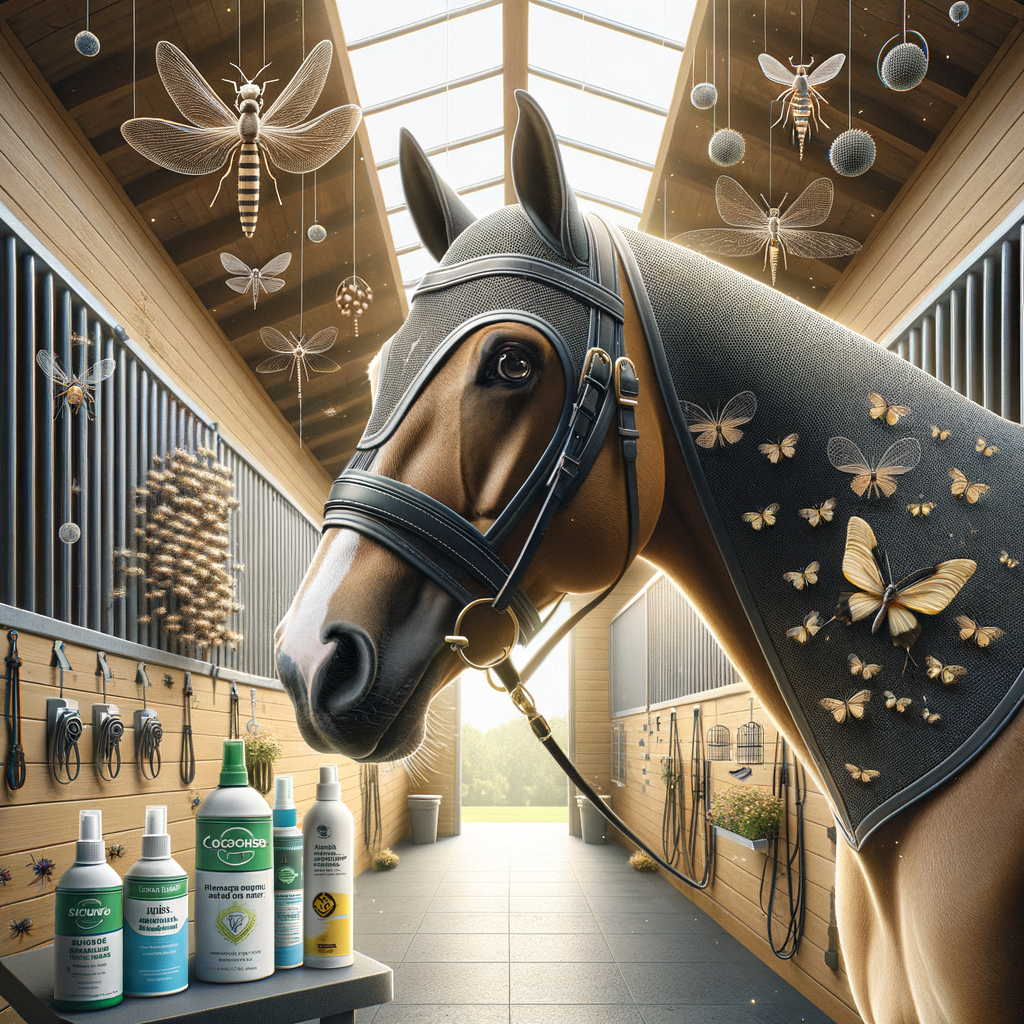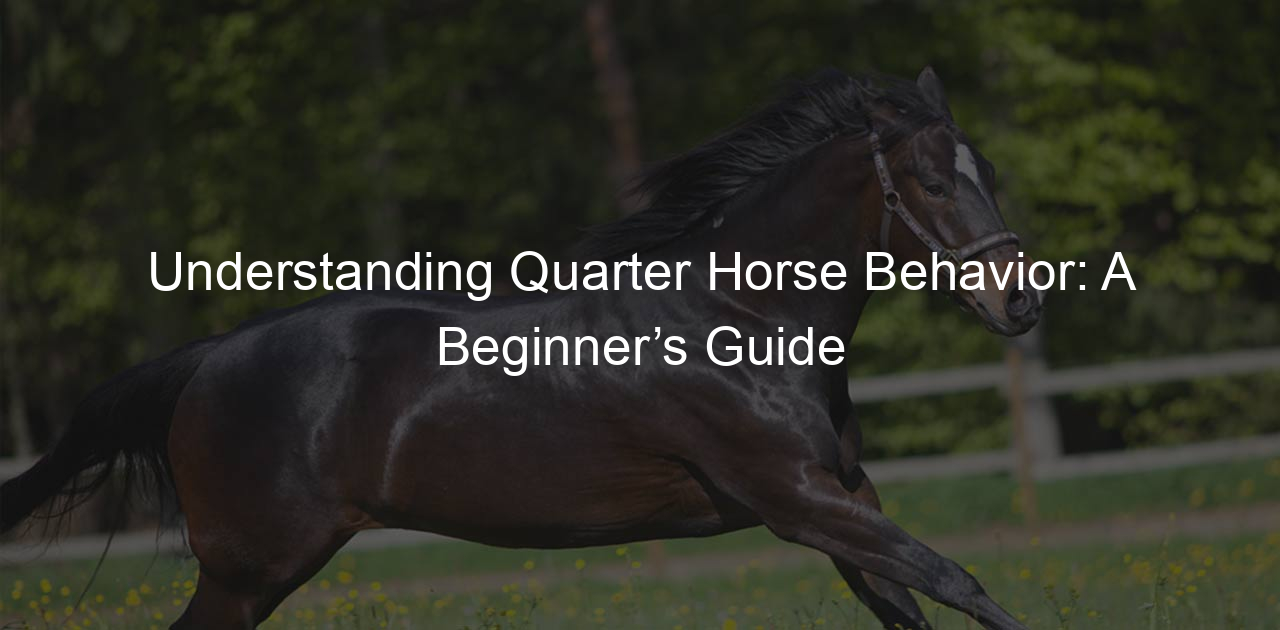
The Best Fly Control Methods for Quarter Horses
-
Introduction to the Issue of Flies in Horse Stables
They can be annoying and cause health issues for horses. Keeping flies under control is important for the well-being of your quarter horse.
-
The Impact of Flies on Quarter Horses
They can lead to skin infections and other health problems. Flies can also spread diseases, making it crucial to manage them effectively.
-
Overview of Fly Control Methods
There are several methods to control flies in horse stables. These include using fly masks, fly traps, and natural repellents. Each method has its own benefits and can help keep your horse comfortable and healthy.
Fly Control for Quarter Horses
Effective Fly Repellents for Horses
- Chemical Fly RepellentsAre widely used to keep flies away from horses. These products often contain ingredients like pyrethrins and permethrin. They are effective but need to be applied regularly.
According to a study, chemical repellents can reduce fly populations by up to 90% when used correctly. However, some horses may have skin reactions to these chemicals.
- Natural Fly RepellentsUse ingredients like essential oils, vinegar, and herbs. They are safer for horses with sensitive skin and are environmentally friendly.
Common natural repellents include citronella, eucalyptus, and lavender oils. These can be applied directly to the horse or used in sprays.
- Comparison of EffectivenessWhen comparing chemical and natural fly repellents, both have their pros and cons. Chemical repellents are generally more potent and longer-lasting but can cause skin irritation. Natural repellents are gentler and safer but may need more frequent application.
Type Effectiveness Application Frequency Safety Chemical High Every few days May cause irritation Natural Moderate Daily Safe
Natural Fly Control for Horses
- Benefits of natural methodsThey are safe for horses, humans, and the environment. Natural methods often cost less in the long run and can be just as effective as chemical options.
- Examples of natural fly control methodsThere are several natural ways to keep flies away from horses:
- Fly Predators: These tiny insects eat fly larvae, stopping flies before they become a problem.
- Herbs and Plants: Plants like lavender, eucalyptus, and marigold can repel flies.
- Essential Oils: Oils such as citronella, eucalyptus, and peppermint can be used in sprays.
- Fly Traps: Natural fly traps can be made using vinegar and sugar to attract and trap flies.
-
Case study: Success with natural fly control
One horse farm in Texas switched to natural fly control methods and saw great results. They used fly predators and planted marigolds around the barn. Within a few weeks, the number of flies decreased by 70%. The horses were happier and healthier, and the farm saved money on chemical repellents.
Horse Fly Management Techniques
Fly Sprays for Quarter Horses
- Review of Top Fly Sprays on the MarketChoosing the right fly spray for your Quarter Horse is crucial. Here are some top-rated options:
Fly Spray Features Price UltraShield EX Long-lasting, weatherproof $20 Endure Sweat-Resistant Sweat-resistant, 14-day protection $25 Pyranha Wipe N’ Spray Quick knockdown, pleasant scent $18 -
How to Properly Apply Fly Spray
Applying fly spray correctly ensures its effectiveness. Follow these steps:
- Shake the bottle well before use.
- Hold the spray bottle about 12 inches away from your horse.
- Spray evenly over the horse’s body, avoiding the eyes and mouth.
- Use a cloth to apply spray to the face and ears.
- Reapply as directed on the product label.
-
Precautions When Using Fly Sprays
While fly sprays are helpful, it’s important to use them safely:
- Always read and follow the instructions on the label.
- Test the spray on a small area first to check for any allergic reactions.
- Keep sprays out of reach of children and pets.
- Store fly sprays in a cool, dry place.
- Use sprays in well-ventilated areas to avoid inhaling fumes.
Preventing Flies in Horse Stables
Keeping flies away from horse stables is crucial for the health and comfort of your horses. Here are some effective methods to prevent flies in horse stables:
- Sanitation Practices: Regular cleaning is essential. Remove manure and soiled bedding daily. Flies are attracted to waste, so keeping the stable clean reduces their breeding grounds. According to a study by the University of Kentucky, proper sanitation can reduce fly populations by up to 50%.
- Use of Fly Traps and Screens: Fly traps and screens are effective tools. Place sticky traps around the stable to catch flies. Screens on windows and doors can prevent flies from entering. A case study from the University of Florida found that using fly traps can decrease fly numbers by 30%.
- Regular Stable Maintenance: Fix any leaks and ensure proper drainage to avoid standing water, which attracts flies. Regularly inspect and repair any damage to the stable structure. Keeping the environment dry and well-maintained discourages flies from settling in.
By following these practices, you can significantly reduce the presence of flies in your horse stables, ensuring a healthier and more comfortable environment for your horses.
Best Fly Masks for Horses
-
Benefits of Using Fly Masks
They keep flies and other bugs away from your horse’s face. This helps to prevent eye infections and irritation. Fly masks also protect your horse’s eyes from the sun. This is important because too much sun can hurt their eyes.
Another benefit is that fly masks can make your horse feel more comfortable. When flies are not buzzing around their face, horses are less stressed and happier. This can lead to better behavior and performance.
-
Top-Rated Fly Masks
Here are some of the best fly masks available:
Brand Features Price Range Cashel Crusader UV protection, soft mesh, durable $20 – $30 Shires Fine Mesh Fine mesh, ear coverage, adjustable $15 – $25 Kensington Fly Mask UV protection, long-lasting, various sizes $25 – $35 -
Tips for Fitting and Using Fly Masks
Here are some tips to help you fit and use fly masks correctly:
- Measure Your Horse: Make sure to measure your horse’s head before buying a fly mask. This helps you get the right size.
- Check for Comfort: The mask should fit snugly but not too tight. Your horse should be able to blink and move its ears.
- Regular Cleaning: Clean the fly mask regularly to keep it free from dirt and bacteria. This helps to prevent infections.
- Inspect Often: Check the mask daily for any signs of wear and tear. Replace it if it becomes damaged.
- Introduce Slowly: If your horse is new to wearing a fly mask, introduce it slowly. Let them wear it for short periods at first.
Fly Traps for Horse Barns
-
- Types of Fly Traps
Some common ones include sticky traps, bait traps, and electric traps. Sticky traps use glue to catch flies. Bait traps attract flies with food or scent. Electric traps zap flies when they touch them.
-
- Placement and Maintenance of Fly Traps
Hang sticky traps near doors and windows. Place bait traps in corners and away from where horses eat. Electric traps should be in areas with lots of flies. Check traps daily and clean them often. Replace bait and sticky traps when they are full.
-
- Effectiveness of Fly Traps
Sticky traps can catch hundreds of flies. Bait traps can reduce fly numbers by attracting and trapping them. Electric traps work well in large barns. Using a mix of traps can help keep your barn fly-free.
| Type of Fly Trap | Best Placement | Maintenance Tips |
|---|---|---|
| Sticky Traps | Near doors and windows | Check daily, replace when full |
| Bait Traps | Corners, away from food | Replace bait regularly |
| Electric Traps | High fly traffic areas | Clean regularly |
Horse Fly Prevention Tips
Fly Control Products for Horses
- Overview of available productsThere are many products available to help keep flies away from horses. These include fly sprays, fly masks, and fly sheets. Each product has its own way of protecting horses from flies.
- Comparison of product effectivenessFly sprays are easy to use and can be applied directly to the horse’s coat. However, they need to be reapplied often. Fly masks cover the horse’s face and ears, providing good protection but can be uncomfortable if not fitted properly. Fly sheets cover the horse’s body and offer the most protection but can be hot in the summer.
Product Effectiveness Pros Cons Fly Sprays Moderate Easy to use Needs frequent reapplication Fly Masks High Good face and ear protection Can be uncomfortable Fly Sheets Very High Full body protection Can be hot -
Recommendations for best products
Fly sprays are great for quick and easy application. Fly masks are essential for protecting the horse’s face and ears. Fly sheets are perfect for full-body protection, especially in areas with heavy fly infestations.
According to Wikipedia, using multiple types of fly control can offer the best protection for horses.
Additional Prevention Tips
- Feeding Practices: Proper feeding practices can help keep flies away from your quarter horse. Clean up any spilled feed immediately to avoid attracting flies. Use feed bins with lids to keep the feed fresh and less appealing to flies. Additionally, consider adding garlic or apple cider vinegar to your horse’s diet, as some studies suggest these can act as natural fly repellents.
- Use of Fans and Other Deterrents: Installing fans in your horse’s barn can help keep flies at bay. Flies are weak fliers and the breeze from fans can make it difficult for them to land on your horse. You can also use fly traps and sticky tapes around the barn to catch flies. Another effective deterrent is using fly sprays specifically designed for horses.
- Regular Vet Check-Ups: Regular veterinary check-ups are crucial for maintaining your horse’s health and preventing fly-related issues. A vet can provide advice on the best fly control methods and check for any infections or diseases that flies might spread. Keeping your horse healthy is a key step in preventing fly infestations.









